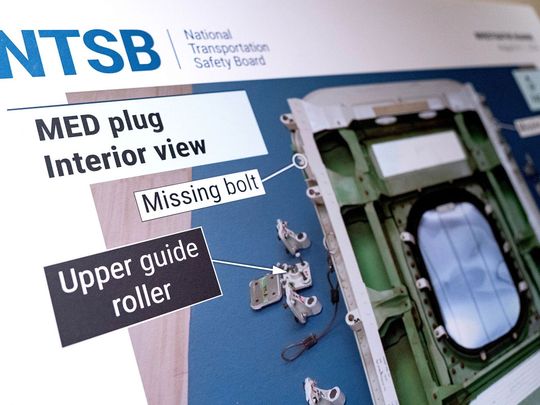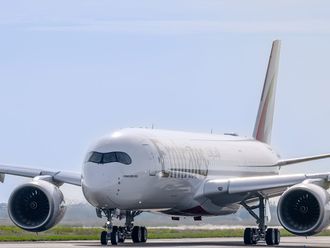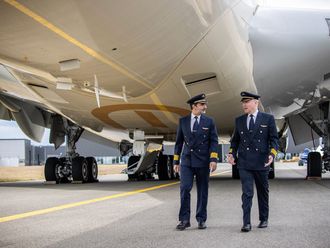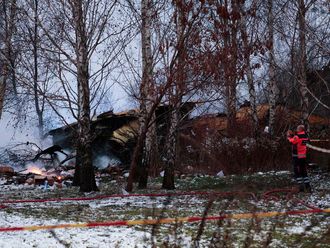
Boeing Co. is redesigning the fuselage component that blew out of a nearly new 737 Max 9 aircraft mid-flight in January, as the planemaker seeks to draw lessons from the accident that has thrown it into crisis.
The company revealed the plan during a day-long hearing with the US National Transportation Safety Board, which grilled executives from Boeing and supplier Spirit AeroSystems Inc. about their safety and manufacturing culture. Boeing said engineers are working on design changes that would prevent the so-called door plug from being closed until it's firmly secured, after the NTSB found the element hadn't been properly reinserted and was missing bolts to hold it down.
read more
- Video: Alaska Air Boeing plane blows out window, fuselage after take-off
- Alaska Air plane blowout: US Federal officials order grounding of Boeing 737 Max 9 jetliners
- Alaska Air says Boeing paid it $160 million in compensation for MAX 9 grounding
- Alaska Air flight attendants are set for 32% increase in pay
Boeing has undergone a comprehensive overhaul since the Jan. 5 accident, switching out senior managers, announcing the repurchase of Spirit and slowing production to improve build quality. NTSB Chair Jennifer Homendy said shortcomings that contributed to the panel mishap had been known for years inside Boeing. At one point in the hearing she reprimanded managers for what she said sounded like an effort to turn the session into a "PR campaign" about Boeing's resurrection from crisis.
"Why does it take a serious tragedy, which could have been so much more serious, for change to occur?" Homendy said, adding that Boeing has "a long way to go "- just based on what I've looked at "- on safety culture."
The NTSB released thousands of pages of information at the start of the hearing about the accident, which involved a jet flown by Alaska Airlines. Interviews with Boeing employees show an at-times overstressed workforce that was well aware of 737 Max fuselages arriving from Spirit with defects.
One employee told investigators that "the planes come in jacked up every day" while another said the aircraft have issues "with structures, skins, open holes."
Boeing is still struggling to leave the accident behind. It announced a new chief executive officer last week, and the company is only now starting to step up its rate of aircraft production again, which had fallen precipitously after the accident, according to Elizabeth Lund, a Boeing senior vice president of quality testifying at the hearing.
Missing bolts
Despite the lack of serious injuries, the accident has attracted huge public interest. The panel was found in a yard shortly afterward, and investigators quickly identified it had been missing bolts to keep it in place.
A preliminary NTSB report found evidence suggesting the door plug was removed prior to leaving the facility to fix damaged rivets and then reinstalled without being properly attached. While the rivet work was entered into Boeing's formal record system, there was no mention of the door removal.
Boeing has said it's missing formal documentation on the panel's removal, a serious violation of its manufacturing protocols. At the hearing, Lund said workers believe they only temporarily pushed the door plug in place to prepare the aircraft to move outside.
Boeing did identify two employees who were likely involved in opening the door plug and moved them into a "lateral position" at the company, Lund said, adding that they were now on paid administrative leave at their own request. The NTSB said it hasn't had a chance to interview the door crew manager, who is on medical leave.
Homendy expressed concern about written statements the NTSB has received from Boeing employees who may have played a role in the door plug's removal, noting they all seem to end with a comment about having zero knowledge of what happened.
'Traveled work'
Since the accident, the planemaker has retrained mechanics and managers. It stepped up inspections, including at Spirit, in an effort to tackle defects and missing parts that lead to so-called "traveled work," where tasks are completed out of the normal sequence.
Boeing has also encouraged employees to submit safety concerns through an internal program called "Speak Up."
But Lloyd Catlin, a business representative for the International Association of Machinists and Aerospace Workers, said at the hearing that the union "- which represents thousands of Boeing workers "- still doesn't have confidence in that program.
"It's in its early phases," he said. "It needs help."











